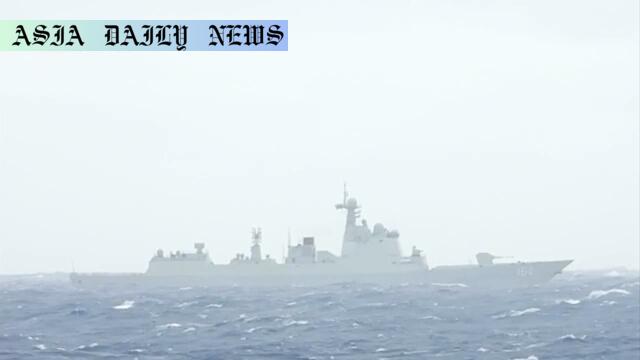Defense Readiness – Taiwan’s Defense Ministry urges enhanced reconnaissance and rapid response to counter China’s military tactics.
China’s military buildup and use of ‘gray zone’ tactics alarms Taiwan.
Taiwan focuses on reconnaissance, rapid response, and asymmetric capabilities.
Collaboration with private industries to develop drones and innovate weaponry.
Taiwanese citizens mobilized to safeguard infrastructure and bolster civil defense.

China’s Rising Threats and Taiwan’s Strategic Response
Taiwan’s Defense Ministry has intensified its efforts to bolster national security in light of escalating concerns over China’s military buildup and frequent ‘gray zone’ engagements. These tactics, which stop short of traditional warfare, are designed to exhaust Taiwan militarily and destabilize morale. The recently released Quadrennial Defense Review highlights the urgent need for enhanced readiness, particularly against the backdrop of a potential blockade or outright aggression. The contents of the review underscore the imperative to strengthen reconnaissance capabilities and rapid military responses. By leveraging these strategies, Taiwan aims not just to counter China’s growing presence but also to reassure its citizens of the nation’s preparedness and resilience.
Utilizing Asymmetric Capabilities to Neutralize Threats
A central tenet of Taiwan’s evolving defense strategy involves the development of asymmetric capabilities. This approach focuses on cost-effective yet highly impactful measures to deter potential aggressors. The review emphasizes the importance of agile weaponry, drones, and advanced reconnaissance systems, emphasizing collaboration between private and public sectors for their production. In aligning military innovation with civilian technological expertise, Taiwan seeks to remain a step ahead of adversaries. By continuously conducting practical military exercises, the country paves the way for real-time adaptations while fostering a culture of vigilance and readiness. Long-term investments in these technologies serve as a beacon of defense innovation for smaller nations facing larger adversaries.
Mobilizing Citizens: A Unified Approach to Defense
Taiwanese authorities understand that national defense is not solely the responsibility of the military. The Quadrennial Defense Review uniquely shines light on a broader strategy that involves mobilizing the general populace. Citizens are tasked with protecting vital infrastructure and ensuring societal stability during crises. By incorporating defense education and shared responsibility, Taiwan fosters a sense of unity and resilience. This comprehensive approach integrates civilian and governmental efforts, ensuring a well-coordinated response to any eventualities. The focus on involving private enterprises further bolsters this shared defense apparatus, creating an effective synergy that strengthens national security holistically.
The Role of Leadership in Taiwan’s Defense Preparedness
Defense Minister Wellington Koo has pledged to keep Taiwan’s military forces ready to act promptly at the slightest indication of imminent threats. Through his leadership, the ministry has committed to ongoing verification and enhancement of rapid response mechanisms. These efforts ensure that any warning signs are promptly identified and dealt with. The emphasis on proactive readiness encapsulates a broader vision of protecting Taiwan’s sovereignty and stability. As Taiwan remains steadfast in these goals, its defense initiatives echo far beyond its borders, serving as a model for other nations navigating complex geopolitical tensions.
Conclusion: Keeping Security a Priority
Amid growing global turbulence and localized threats, Taiwan’s focus on defense readiness is a testament to its resilience. The Quadrennial Defense Review not only highlights the immediate challenges posed by China but also underscores the importance of preparedness in an uncertain world. Taiwan’s strategic initiatives — integrating asymmetric capabilities, utilizing rapid response frameworks, and mobilizing citizenry — reflect comprehensive and forward-thinking defense measures. By maintaining collaboration across all sectors, Taiwan continues to pave the way for innovative security solutions, ensuring its status as a stronghold of democracy and freedom in the region. Moving forward, sustained investment and focus will be key in preserving these values while navigating an increasingly complex geopolitical landscape.



Commentary
The Growing Importance of Defense Preparedness
Reading Taiwan’s Quadrennial Defense Review is an eye-opening reminder of the escalating complexities nations face in contemporary geopolitical landscapes. While strategies and policies to counteract conventional warfare remain relevant, the rise of ‘gray zone’ tactics signifies that defense readiness must evolve alongside these subtle challenges. By acknowledging these threats, Taiwan demonstrates an acute understanding of the emerging dynamics that confront sovereign nations, particularly those in high-stakes geopolitical environs like East Asia.
Collaboration as a Frontline Strategy
One of the standout aspects of Taiwan’s approach is its emphasis on collaboration—between military entities, private industries, and citizens. This interconnected defense model ensures that no resource is left untapped. Encouraging private industries to contribute to military innovations cleverly harnesses Taiwan’s vibrant tech sector, creating a unique synergy between civilian ingenuity and governmental resolve. Such strategies offer lessons for other nations aiming to modernize their defense apparatus while managing costs effectively.
Empowering the People
What I find truly inspiring is Taiwan’s advocacy for public involvement in national security. Engaging citizens in defense ensures a unified front during times of crises. This model not only builds resilience but also fortifies societal ties by instilling a shared purpose. In an era where state actors cannot solely rely on traditional military strength, integrating the public into actions like infrastructure protection and preparedness drills represents a forward-thinking approach to holistic defense mechanisms.
Final Thoughts
Taiwan’s defense strategies showcase an intelligent blend of traditional and modern approaches to securing sovereignty and fostering resilience. At a time when global tensions appear inevitable, such proactive measures signal immense foresight. As Taiwan sets a precedent for defense innovation and citizen mobilization, it carves out a leadership role that smaller nations can look to, demonstrating how a united effort can counter even the most formidable of adversaries. These strategies are worth emulating for any nation hoping to navigate the delicate balance of maintaining peace while preparing for contingencies.